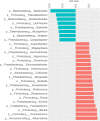Systemic sclerosis is associated with specific alterations in gastrointestinal microbiota in two independent cohorts
- PMID: 28761687
- PMCID: PMC5508636
- DOI: 10.1136/bmjgast-2017-000134
Systemic sclerosis is associated with specific alterations in gastrointestinal microbiota in two independent cohorts
Abstract
Objective: To compare faecal microbial composition in patients with systemic sclerosis (SSc) from 2 independent cohorts with controls and to determine whether certain genera are associated with SSc-gastrointestinal tract (GIT) symptoms.
Design: Adult patients with SSc from the University of California, Los Angeles (UCLA) and Oslo University Hospital (OUH) and healthy controls participated in this study (1:1:1). All participants provided stool specimens for 16S rRNA sequencing. Linear discriminant analysis effect size demonstrated genera with differential expression in SSc. Differential expression analysis for sequence count data identified specific genera associated with GIT symptoms as assessed by the GIT 2.0 questionnaire.
Results: The UCLA-SSc and OUH-SSc cohorts were similar in age (52.1 and 60.5 years, respectively), disease duration (median (IQR): 6.6 (2.5-16.4) and 7.0 (1.0-19.2) years, respectively), gender distribution (88% and 71%, respectively), and GIT symptoms (mean (SD) total GIT 2.0 scores of 0.7 (0.6) and 0.6 (0.5), respectively). Principal coordinate analysis illustrated significant microbial community differences between SSc and controls (UCLA: p=0.001; OUH: p=0.002). Patients with SSc had significantly lower levels of commensal genera deemed to protect against inflammation, such as Bacteroides (UCLA and OUH), Faecalibacterium (UCLA), Clostridium (OUH); and significantly higher levels of pathobiont genera, such as Fusobacterium (UCLA), compared with controls. Increased abundance of Clostridium was associated with less severe GIT symptoms in both cohorts.
Conclusions: The present analysis detected specific aberrations in the lower GIT microbiota of patients with SSc from 2 geographically and ethnically distinct cohorts. These findings suggest that GIT dysbiosis may be a pathological feature of the SSc disease state.
Keywords: AUTOIMMUNE DISEASE; INTESTINAL MICROBIOLOGY; SYSTEMIC SCLEROSIS.
Conflict of interest statement
Competing interests: None declared.
Figures





References
-
- Lock G, Holstege A, Lang B, et al. Gastrointestinal manifestations of progressive systemic sclerosis. Am J Gastroenterol 1997;92:763–71. - PubMed
-
- Sallam H, McNearney TA, Chen JD. Systematic review: pathophysiology and management of gastrointestinal dysmotility in systemic sclerosis (scleroderma). Aliment Pharmacol Ther 2006;23:691–712. doi:10.1111/j.1365-2036.2006.02804.x - DOI - PubMed
-
- Marie I, Ducrotté P, Denis P, et al. Small intestinal bacterial overgrowth in systemic sclerosis. Rheumatology 2009;48:1314–19. doi:10.1093/rheumatology/kep226 - DOI - PubMed
-
- Franck-Larsson K, Graf W, Rönnblom A. Lower gastrointestinal symptoms and quality of life in patients with systemic sclerosis: a population-based study. Eur J Gastroenterol Hepatol 2009;21:176–82. doi:10.1097/MEG.0b013e32831dac75 - DOI - PubMed
-
- Bodukam V, Hays RD, Maranian P, et al. Association of gastrointestinal involvement and depressive symptoms in patients with systemic sclerosis. Rheumatology (Oxford) 2011;50:330–4. doi:10.1093/rheumatology/keq296 - DOI - PMC - PubMed
Grants and funding
LinkOut - more resources
Full Text Sources
Other Literature Sources
Medical
